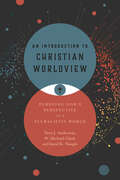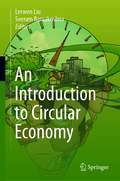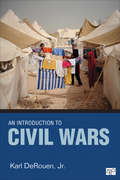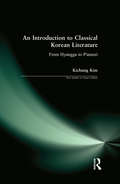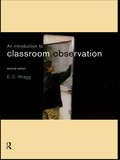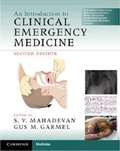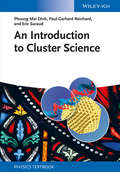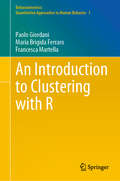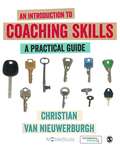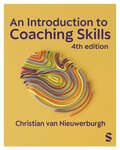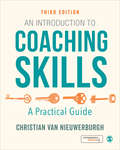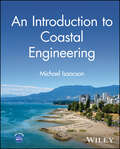- Table View
- List View
An Introduction to Christian Theology
by Richard J. Plantinga Thomas R. Thompson Matthew D. Lundberg Richard J. Plantinga Thomas R. ThompsonFar from being solely an academic enterprise, the practice of theology can pique the interest of anyone who wonders about the meaning of life. Inviting readers on a journey of 'faith seeking understanding', this introduction to Christian theology - its basic concepts, confessional content, and history - emphasizes the relevance of the key convictions of Christian faith to the challenges of today's world. In the first part, this book introduces the project of Christian theology and sketches the critical context that confronts Christian thought and practice today. In a second part, it offers a survey of the key doctrinal themes of Christian theology - including revelation, the triune God, and the world as creation - identifying their biblical basis and the highlights of their historical development before giving a systematic evaluation of each theme. The third part provides an overview of Christian theology from the early church to the present.
An Introduction to Christian Theology (Introduction to Religion)
by Matthew D. Lundberg Richard J. Plantinga Thomas R. ThompsonFar from being solely an academic enterprise, the practice of theology can pique the interest of anyone who wonders about the meaning of life. This introduction to Christian theology – exploring its basic concepts, confessional content, and history – emphasizes the relevance of the key convictions of Christian faith to the challenges of today's world. Part I introduces the project of Christian theology and sketches the critical context that confronts Christian thought and practice today. Part II offers a survey of the key doctrinal themes of Christian theology, including revelation, the triune God, and the world as creation, identifying their biblical basis and the highlights of their historical development before giving a systematic evaluation of each theme. Part III provides an overview of Christian theology from the early church to the present. Thoroughly revised and updated, the second edition of An Introduction to Christian Theology includes a range of new visual and pedagogical features, including images, diagrams, tables, and more than eighty text boxes, which call attention to special emphases, observations, and applications to help deepen student engagement.
An Introduction to Christian Worldview: Pursuing God's Perspective in a Pluralistic World
by Tawa J. Anderson W. Michael Clark David K. NaugleAn Introduction to Christian WorldviewWhy do worldviews matter?What characterizes a Christian worldview?How can we analyze and describe a worldview? What are the most common secular and religious worldviews? An Introduction to Christian Worldview
An Introduction to Circular Economy
by Seeram Ramakrishna Lerwen LiuThis book is purposefully styled as an introductory textbook on circular economy (CE) for the benefit of educators and students of universities. It provides comprehensive knowledge exemplified by practices from policy, education, R&D, innovation, design, production, waste management, business and financing around the world. The book covers sectors such as agriculture/food, packaging materials, build environment, textile, energy, and mobility to inspire the growth of circular business transformation. It aims to stimulate action among different stakeholders to drive CE transformation. It elaborates critical driving forces of CE including digital technologies; restorative innovations; business opportunities & sustainable business model; financing instruments, regulation & assessment and experiential education programs. It connects a CE transformation for reaching the SDGs2030 and highlights youth leadership and entrepreneurship at all levels in driving the sustainability transformation.
An Introduction to Civics and Citizenship Education: A Machine-Generated Literature Overview
by Keith HeggartThis book serves as a starting point for pre-service teachers and researchers by providing a concise and thorough summary of key themes within the field of civics and citizenship education. The field of civics and citizenship education is both complex and contested in local and international jurisdictions. It is also a key site for political and policy interventions by governments and other interested parties. While this activity makes the field a vibrant one, it also means that it can be challenging for teachers and researchers to enter and understand the ongoing debates and discussions and the implications these present for their research and educational practice. The book begins with a detailed examination of the history of civics and citizenship education from a variety of perspectives and in different locations. It recognizes and documents how the place and importance of civics and citizenship education has changed over the last century and how this has been realized in various educational initiatives. It also examines the current state of educational and policy-level initiatives in civics and citizenship education, noting the differences between different state and country approaches. This book also undertakes a detailed consideration of the different typologies of civics and citizenship education that have been formulated by various researchers, including notions like justice-oriented citizenship, activist citizenship, and critical citizenship. It examines the theoretical foundations of both active citizenship education and global citizenship education and how these have been enacted in school settings. Furthermore, it examines the place of citizenship in higher education institutions and non-formal educational settings, including practices and statements about the importance of developing global citizenship in these arenas. It also presents a number of different case studies showcasing the variety of approaches to civics and citizenship education and discusses the opportunities and challenges educators and researchers face when researching and implementing it.
An Introduction to Civil Wars
by Karl R. DerouenAn Introduction to Civil Wars provides a comprehensive overview of the civil wars that have taken place globally since World War II. A discussion of the human and economic costs of civil war is followed by a systematic examination of all aspects of these conflicts: civil war patterns, types, and causes; the effect of natural resources; conflict duration, outcomes, and termination; peace agreements; counterinsurgency; terrorism; international intervention; and post-conflict issues. Author Karl DeRouen, Jr. draws on the latest empirical research, and pedagogical features -- tables, figures, maps, photos, a comprehensive bibliography, lists of suggested readings, and an Appendix listing all civil wars since 1946 -- make the book an especially useful research tool for undergraduates and graduate students in political science and public policy.
An Introduction to Classical Korean Literature: From Hyangga to P'ansori
by Kichung KimThis work provides an introduction to some of the most important and representative genres of classical Korean literature. Coverage includes: Samguk sagi and samguk yusa as literature; Kunmong and Unyongchon; the lyricism of Koryo songs; and the literature of Chosen Dynasty Women.
An Introduction to Classical Nahuatl
by Christopher Mackay Michel LauneyNow available to an English-speaking audience, this book is a comprehensive grammar of classical Nahuatl, the literary language of the Aztecs. It offers students of Nahuatl a complete and clear treatment of the language's structure, grammar and vocabulary. It is divided into 35 chapters, beginning with basic syntax and progressing gradually to more complex structures. Each grammatical concept is illustrated clearly with examples, exercises and passages for translation. A key is provided to allow students to check their answers. By far the most approachable textbook of Nahuatl available, this book will be an excellent teaching tool both for classroom use and for readers pursuing independent study of the language. It will be an invaluable resource to anthropologists, ethnographers, historians, archaeologists and linguists alike.
An Introduction to Classroom Observation
by Ted WraggThe first edition of this book was a bestseller, and is generally regarded as the most widely used and authoritative text on this topic. This completely revised and updated second edition takes into account the latest changes in educational practice, and includes coverage of recent developments in teacher appraisal and school inspection procedures. Ted Wragg is an international expert on research into teaching and learning, but has always been someone who writes with the teacher in mind. Using a combination of case studies, photographs and illustrations, Wragg shows how various people study lessons for different purposes and in different contexts. He explains a number of approaches in clear language and gives examples of successful methods that have been employed by teachers, student teachers, researchers and pupils. This is an essential text for anyone serious about becoming a good teacher or researcher in education.
An Introduction to Classroom Observation (Classic Edition)
by Ted WraggHow does classroom observation support your professional development? How can you observe as effectively as possible? Highly regarded as one of the most widely used and authoritative texts on this topic, An Introduction to Classroom Observation is an essential text for anyone serious about becoming a good teacher or researcher in education. Now part of the Routledge Education Classic Edition Series, E.C. Wragg’s straightforward guide includes a combination of case studies, photographs and illustrations to show how various people study lessons for different purposes and in different contexts. It outlines a range of approaches in clear language and gives examples of successful methods that have been employed by teachers, student teachers, researchers and pupils. With a new preface from Professor Richard Pring, the classic edition of this indispensible text is for a new generation of education professionals serious about becoming good teachers and researchers.
An Introduction to Climate Change Economics and Policy (Routledge Textbooks in Environmental and Agricultural Economics)
by Elissaios Papyrakis Felix R. FitzRoyThe 2nd edition of An Introduction to Climate Change Economics and Policy explains the key scientific, economic and policy issues related to climate change in a completely up-to-date introduction for anyone interested, and students at all levels in various related courses, including environmental economics, international development, geography, politics and international relations. FitzRoy and Papyrakis highlight how economists and policymakers often misunderstand the science of climate change, underestimate the growing threat to future civilization and survival and exaggerate the costs of radical measures needed to stabilize the climate. In contrast, they show how direct and indirect costs of fossil fuels – particularly the huge health costs of local pollution – actually exceed the investment needed for transition to an almost zero carbon economy in two or three decades using available technology.
An Introduction to Clinical Emergency Medicine
by Gus M. Garmel S. V. MahadevanBuilding on the strengths of its award-winning predecessor, this new edition of An Introduction to Clinical Emergency Medicine is a must-have resource for individuals training and practising in this challenging specialty. Guided by the patient's chief complaint, this text presents a concise, methodical approach to patient evaluation, management and problem solving in the Emergency Department. Unlike other textbooks, which elaborate on known diagnoses, this extraordinary book approaches clinical problems as clinicians approach patients - without full knowledge of the final diagnosis. Fully revised and updated, the second edition includes new chapters on sepsis, bleeding, burns, neonatal, alcohol-related, and dental emergencies. Stunning full-color chapters include clinical images (photographs, ECGs and radiologic studies), detailed illustrations and practical tables. Written and edited by experienced educators, researchers, and practitioners in Emergency Medicine, this text is core reading for students and residents, and an important resource for practising emergency physicians, faculty, and other healthcare providers.
An Introduction to Clinical Emergency Medicine
by Gus M. Garmel S. V. MahadevanBuilding on the strengths of its award-winning predecessor, this new edition of An Introduction to Clinical Emergency Medicine is a must-have resource for individuals training and practising in this challenging specialty. Guided by the patient's chief complaint, this text presents a concise, methodical approach to patient evaluation, management and problem solving in the Emergency Department. Unlike other textbooks, which elaborate on known diagnoses, this extraordinary book approaches clinical problems as clinicians approach patients - without full knowledge of the final diagnosis. Fully revised and updated, the second edition includes new chapters on sepsis, bleeding, burns, neonatal, alcohol-related, and dental emergencies. Stunning full-color chapters include clinical images (photographs, ECGs and radiologic studies), detailed illustrations and practical tables. Written and edited by experienced educators, researchers, and practitioners in Emergency Medicine, this text is core reading for students and residents, and an important resource for practising emergency physicians, faculty, and other healthcare providers.
An Introduction to Cluster Science
by Paul-Gerhard Reinhard Phuong Mai Dinh Eric SuraudFilling the need for a solid textbook, this short primer in cluster science is ideal for a one-semester lecture for advanced undergraduate students. It is based on a series of lectures given by the well-established and recognized authors for the past ten years. The book covers both the basics of the domain as well as up-to-date developments. It can be divided roughly into two parts. The first three chapters introduce basic concepts of cluster science. Chapter 1 provides a general introduction, complemented by chapter 2 on experimental and chapter 3 on theoretical aspects. The second half of the book is devoted to a systematic presentation of free cluster properties, and to a thorough discussion of the impact of clusters in other domains of science. These explicitly worked-out links between cluster physics and other research areas are unique both in terms of fundamental aspects and of applications, and cannot be found elsewhere in the literature. Also suitable for researchers outside of the field looking for an introduction to cluster science.
An Introduction to Clustering with R (Behaviormetrics: Quantitative Approaches to Human Behavior #1)
by Maria Brigida Ferraro Paolo Giordani Francesca MartellaThe purpose of this book is to thoroughly prepare the reader for applied research in clustering. Cluster analysis comprises a class of statistical techniques for classifying multivariate data into groups or clusters based on their similar features. Clustering is nowadays widely used in several domains of research, such as social sciences, psychology, and marketing, highlighting its multidisciplinary nature. This book provides an accessible and comprehensive introduction to clustering and offers practical guidelines for applying clustering tools by carefully chosen real-life datasets and extensive data analyses. The procedures addressed in this book include traditional hard clustering methods and up-to-date developments in soft clustering. Attention is paid to practical examples and applications through the open source statistical software R. Commented R code and output for conducting, step by step, complete cluster analyses are available. The book is intended for researchers interested in applying clustering methods. Basic notions on theoretical issues and on R are provided so that professionals as well as novices with little or no background in the subject will benefit from the book.
An Introduction to Cluttering: A Practical Guide for Speech-Language Pathology Students, Clinicians, and Researchers
by Yvonne van Zaalen Isabella ReichelAn Introduction to Cluttering explores the speech disorder of cluttering, offering concrete, evidence-based methods for its diagnosis and treatment.Cluttering is a globally recognized communication disorder, yet it is often poorly understood. This book presents a historical overview of the efforts of pioneers in the field to demystify the cluttering disorder, before introducing the aetiology and symptoms of cluttering from several perspectives: physiological, psycho-linguistic, neurological, social, affective, and cognitive. It also provides an in-depth discussion of the identification, differential diagnosis, and assessment of cluttering, using current and advanced diagnostic procedures before explaining the rationales and unique, innovative procedures for evidence-based treatments of cluttering. Engaging practical examples and theory boxes are featured throughout the book.Providing effective and user-friendly procedures for cluttering diagnosis and intervention, this book is an essential read for all current and future speech and language therapists.
An Introduction to Coaching
by Graham Dexter Judy Irving Dr Janice DexterThis is an excellent, no-nonsense introduction to the field of coaching for developing practitioners. Using a rich array of examples from both life and business coaching, the book covers: o foundations of coaching o coaching processes o the range of coaching models, skills, attitudes and methods o the psychological underpinnings to the main theoretical approaches to coaching, e.g. cognitive, TA, NLP o different applications of coaching e.g in life-, executive- , or career-coaching o key professional issues such as ethics, evidence-based practice and contracts. o how to present and market your coaching identity and skills. Blending theory and practice, with examples and exercises, the book is aimed at professionals from a range of backgrounds, whether therapeutic, educational or business in orientation, who want to expand and transfer their skills to the coaching profession. It is essential reading on all coaching & mentoring courses.
An Introduction to Coaching Skills
by Christian Van NieuwerburghAn Introduction to Coaching Skills is an invaluable resource for novice and trainee coaches. Its accessible, step-by-step style acquaints you with the key skills needed to become a successful coach and, with its focus on the applied side of coaching, the book is an essential text for anyone starting out on their coaching voyage. From the 'how to', through to practicalities and challenges and honing existing skills, this book covers: - Definitions of coaching - How to become a coach - Key coaching skills - Current coaching models - Practical tools and techniques - Reflective practise and how best to help others With evidence-based research, activities and suggestions for further reading, this is a clear and practical, all-you-need guide to becoming a coach.
An Introduction to Coaching Skills: A Practical Guide
by Christian van NieuwerburghThis bestselling book introduces you step-by-step to the key skills needed to become a successful coach. Focusing on the main coaching skills of listening, asking powerful questions, playing back and noticing, this practical book supports you to become more self-aware and confident as you support others to learn, grow and develop. Supported by a suite of video examples and practical activities, this book is an invaluable companion for novices and trainee coaches. Now in its fourth edition, this book is more aligned to the competencies of the leading professional associations of coaching and has been revised and updated to take into account developments in the field. New to Fourth Edition: New learning features, including "What the professional associations say", "Reflect on your practice", and "A question for you" New suite of 30 online video examples displaying a range of key coaching skills in action New chapter on "coaching in context" on the implications of coaching in different contexts, such as education and health settings Increased focus on online coaching
An Introduction to Coaching Skills: A Practical Guide
by Christian van NieuwerburghThis bestselling book introduces you step-by-step to the key skills needed to become a successful coach. Focusing on the main coaching skills of listening, asking powerful questions, playing back and noticing, this practical book supports you to become more self-aware and confident as you support others to learn, grow and develop. Supported by a suite of video examples and practical activities, this book is an invaluable companion for novices and trainee coaches. Now in its fourth edition, this book is more aligned to the competencies of the leading professional associations of coaching and has been revised and updated to take into account developments in the field. New to Fourth Edition: New learning features, including "What the professional associations say", "Reflect on your practice", and "A question for you" New suite of 30 online video examples displaying a range of key coaching skills in action New chapter on "coaching in context" on the implications of coaching in different contexts, such as education and health settings Increased focus on online coaching
An Introduction to Coaching Skills: A Practical Guide
by Dr Christian Van NieuwerburghThis text is an invaluable resource for novice and trainee coaches. Its accessible, step-by-step style acquaints you with the key skills needed to become a successful coach. It takes you from the 'how to', through to practicalities and challenges, and beyond to the continued development of your skills. There is even more packed into the new edition, with: over 70 videos of real coaching; including two full length sessions for you to engage with a closer look at coaching processes and models to support your understanding new activities (including templates to download) to try with clients stories from practice to give context to the skills being discussed. A world-wide success, this is a stimulating, inspiring and hugely practical book that you’ll come back to time and time again.
An Introduction to Coaching Skills: A Practical Guide
by Dr Christian Van NieuwerburghThis text is an invaluable resource for novice and trainee coaches. Its accessible, step-by-step style acquaints you with the key skills needed to become a successful coach. It takes you from the 'how to', through to practicalities and challenges, and beyond to the continued development of your skills. There is even more packed into the new edition, with: over 70 videos of real coaching; including two full length sessions for you to engage with a closer look at coaching processes and models to support your understanding new activities (including templates to download) to try with clients stories from practice to give context to the skills being discussed. A world-wide success, this is a stimulating, inspiring and hugely practical book that you’ll come back to time and time again.
An Introduction to Coaching Skills: A Practical Guide
by Dr. Christian van NieuwerburghThis bestselling book introduces you step-by-step to the key skills needed to become a successful coach. Supported by an Online Resource site with over 70 videos of coaching in action, this practical book will be an invaluable resource for novices and trainee coaches. To access the exclusive SAGE Videos, please see the code on the inside front cover of your textbook and click on &“Login&” above. If you have purchased the eBook from Amazon or another online retailer, please email UK.DigitalContent DigitalContent@sagepub.co.uk> with the subject line &“Access Code Required&” and we will assist further.
An Introduction to Coaching Skills: A Practical Guide
by Dr. Christian van NieuwerburghThis bestselling book introduces you step-by-step to the key skills needed to become a successful coach. Supported by an Online Resource site with over 70 videos of coaching in action, this practical book will be an invaluable resource for novices and trainee coaches. To access the exclusive SAGE Videos, please see the code on the inside front cover of your textbook and click on &“Login&” above. If you have purchased the eBook from Amazon or another online retailer, please email UK.DigitalContent DigitalContent@sagepub.co.uk> with the subject line &“Access Code Required&” and we will assist further.
An Introduction to Coastal Engineering
by Michael IsaacsonUnderstand and respond to a changing coastline with this comprehensive reference Coastal engineering concerns society’s interactions with coastlines and relates, for example, to coastal flooding, beach erosion, seawalls and breakwaters, and the design of marinas. As climate change drives sea level rise, coastal engineering is critical in responding to increased coastal flooding and receding shorelines. The need to develop coastal infrastructure while minimizing environmental impacts makes this a vital field. An Introduction to Coastal Engineering offers a comprehensive overview of this subject, designed to bridge existing gaps in the general civil engineering literature. Covering all major aspects of coastal engineering, including ocean wave behaviour, structures, sediments, mixing processes, and modelling, the book emphasizes practical solutions and applications for students and practicing engineers alike. Thorough and rigorous, yet highly readable, the book is a must-own tool for developing solutions towards a sustainable coastal future. An Introduction to Coastal Engineering readers will also find: Pertinent descriptions of wave theories, wave transformations, and random wavesDetailed discussion of practical solutions, recent advancements in the field, and up-to-date data sourcesWorked-through examples and end-of-chapter problems with some written assignmentsA spreadsheet appendix containing a set of reference solutions An Introduction to Coastal Engineering is ideal for students in upper-level undergraduate and graduate courses in coastal engineering, practicing coastal engineers, and other engineers engaged in coastal flood protection, waterfront development projects, and the minimization of environmental impacts along shorelines.


